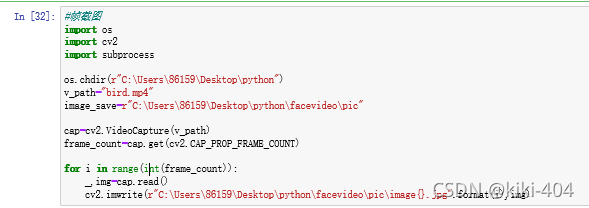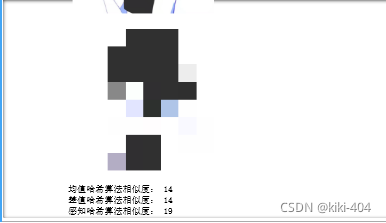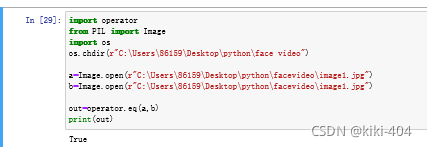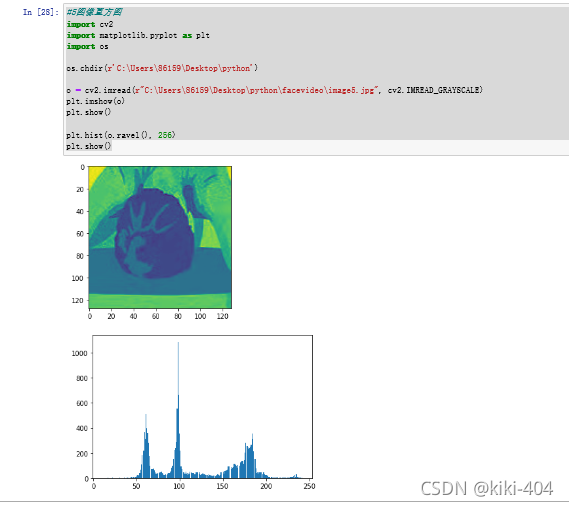练习1:提取视频中的每一帧
#帧截图
import os
import cv2
import subprocess
os.chdir(r"C:\Users\86159\Desktop\python")
v_path="bird.mp4"
image_save=r"C:\Users\86159\Desktop\python\facevideo\pic"
cap=cv2.VideoCapture(v_path)
frame_count=cap.get(cv2.CAP_PROP_FRAME_COUNT)
for i in range(int(frame_count)):
_,img=cap.read()
cv2.imwrite(r"C:\Users\86159\Desktop\python\facevideo\pic\image{}.jpg".format(i),img)
报错:
1.for语法没加空格出错,要严格遵循格式
2.路径前面加r,解决神秘错误
3.pic截图文件夹要先建立好
练习2:图片对比
import cv2
import numpy as np
import matplotlib.pyplot as plt
import os
os.chdir(r'C:\Users\86159\Desktop\python')
def aHash(img):
# 缩放为8*8
plt.imshow(img)
plt.axis("off") #去掉坐标轴
plt.show()
img = cv2.resize(img, (8, 8))
plt.imshow(img)
plt.axis("off") #去掉坐标轴
plt.show()
# 转换为灰度图
gray = cv2.cvtColor(img,cv2.COLOR_BGR2GRAY)
# s为像素和初值为0,hash_str为hash值初值为''
s = 0
hash_str = ""
# 遍历累加求像素和
for i in range(8):
for j in range(8):
s = s + gray[i, j]
# 求平均灰度
avg = s / 64
# 灰度大于平均值为1相反为0生成图片的hash值
for i in range(8):
for j in range(8):
if gray[i, j] > avg:
hash_str = hash_str + "1"
else:
hash_str = hash_str + "0"
return hash_str
# 差值感知算法
def dHash(img):
# 缩放8*8
img = cv2.resize(img, (9, 8))
# 转换灰度图
gray = cv2.cvtColor(img, cv2.COLOR_BGR2GRAY)
hash_str = ''
# 每行前一个像素大于后一个像素为1,相反为0,生成哈希
for i in range(8):
for j in range(8):
if gray[i, j] > gray[i, j + 1]:
hash_str = hash_str + '1'
else:
hash_str = hash_str + '0'
return hash_str
# 感知哈希算法(pHash)
def pHash(img):
# 缩放32*32
img = cv2.resize(img, (32, 32)) # , interpolation=cv2.INTER_CUBIC
# 转换为灰度图
gray = cv2.cvtColor(img, cv2.COLOR_BGR2GRAY)
# 将灰度图转为浮点型,再进行dct变换
dct = cv2.dct(np.float32(gray))
# opencv实现的掩码操作
dct_roi = dct[0:8, 0:8]
hash = []
avreage = np.mean(dct_roi)
for i in range(dct_roi.shape[0]):
for j in range(dct_roi.shape[1]):
if dct_roi[i, j] > avreage:
hash.append(1)
else:
hash.append(0)
return hash
# 通过得到RGB每个通道的直方图来计算相似度
def classify_hist_with_split(image1, image2, size=(256, 256)):
# 将图像resize后,分离为RGB三个通道,再计算每个通道的相似值
image1 = cv2.resize(image1, size)
image2 = cv2.resize(image2, size)
plt.imshow(image1)
plt.show()
plt.axis('off')
plt.imshow(image2)
plt.show()
plt.axis('off')
sub_image1 = cv2.split(image1)
sub_image2 = cv2.split(image2)
sub_data = 0
for im1, im2 in zip(sub_image1, sub_image2):
sub_data += calculate(im1, im2)
sub_data = sub_data / 3
return sub_data
# 计算单通道的直方图的相似值
def calculate(image1, image2):
hist1 = cv2.calcHist([image1], [0], None, [256], [0.0, 255.0])
hist2 = cv2.calcHist([image2], [0], None, [256], [0.0, 255.0])
plt.plot(hist1, color="r")
plt.plot(hist2, color="g")
plt.show()
# 计算直方图的重合度
degree = 0
for i in range(len(hist1)):
if hist1[i] != hist2[i]:
degree = degree + (1 - abs(hist1[i] - hist2[i]) / max(hist1[i], hist2[i]))
else:
degree = degree + 1
degree = degree / len(hist1)
return degree
def cmpHash(hash1, hash2):
n = 0
# hash长度不同则返回-1代表传参出错
if len(hash1)!=len(hash2):
return -1
# 遍历判断
for i in range(len(hash1)):
# 不相等则n计数+1,n最终为相似度
if hash1[i] != hash2[i]:
n = n + 1
return n
img1 = cv2.imread(r"C:\Users\86159\Desktop\python\facevideo\image1.jpg") # 11--- 16 ----13 ---- 0.43
img2 = cv2.imread(r"C:\Users\86159\Desktop\python\facevideo\image2.jpg")
hash1 = aHash(img1)
hash2 = aHash(img2)
n = cmpHash(hash1, hash2)
print("均值哈希算法相似度:", n)
hash1 = dHash(img1)
hash2 = dHash(img2)
n = cmpHash(hash1, hash2)
print("差值哈希算法相似度:", n)
hash1 = pHash(img1)
hash2 = pHash(img2)
n = cmpHash(hash1, hash2)
print("感知哈希算法相似度:", n)
n = classify_hist_with_split(img1, img2)
print("三直方图算法相似度:", n)
报错:
1.文件夹命名不要中文也不要空格
2.路径前加r
?练习3:基于相等判断图像是否相同
import operator
from PIL import Image
import os
os.chdir(r"C:\Users\86159\Desktop\python\face video")
a=Image.open(r"C:\Users\86159\Desktop\python\facevideo\image1.jpg")
b=Image.open(r"C:\Users\86159\Desktop\python\facevideo\image1.jpg")
out=operator.eq(a,b)
print(out)
?练习3:图片直方图
#5图像直方图
import cv2
import matplotlib.pyplot as plt
import os
os.chdir(r'C:\Users\86159\Desktop\python')
o = cv2.imread(r"C:\Users\86159\Desktop\python\facevideo\image5.jpg", cv2.IMREAD_GRAYSCALE)
plt.imshow(o)
plt.show()
plt.hist(o.ravel(), 256)
plt.show()
?报错:
1.TypeError: Image data of dtype object cannot be converted to float? 可能是图片像素太大,或者是路径中忘记加图片类型。
2.路径前要加r
练习4:图片处理——做灰度图
from PIL import Image
import os
import matplotlib.pyplot as plt
print(os.getcwd())
os.chdir(r"C:\Users\86159\Desktop\python")
print(os.getcwd())
im=Image.open(r"C:\Users\86159\Desktop\python\face video\image1.jpg").convert("L")
print(im.format,im.size,im.mode)#im.show())
plt.imshow(im)
plt.title("Image Processing@CUC")
plt.axis("off")
plt.show()

?报错:
1.前面的引用部分注意格式